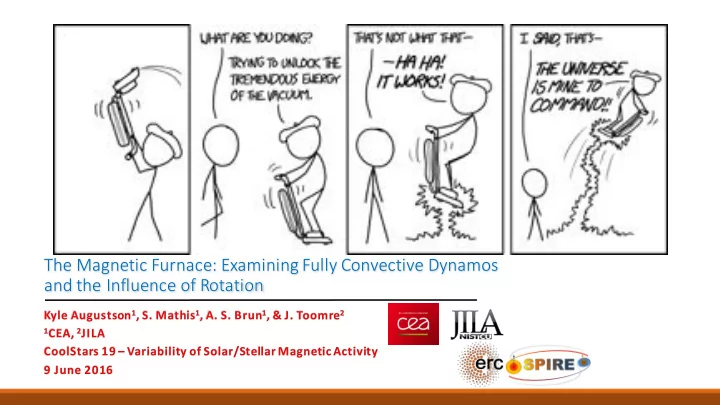

The Magnetic Furnace: Examining Fully Convective Dynamos and the Influence of Rotation
Fully Convective Dynamos in Rapidly Rotating Regimes • Liquid Cores of Rocky Planets • Giant Planets with Deep Convection Zones • Low Mass M Dwarfs • Red Giant He Burning Cores • Cores of Main-Sequence Intermediate and High Mass Stars
Questions Potentially Addressed with Global-Scale Simulations What differences arise between HD and MHD? Impact for 1-D models How do a greater luminosity and a changing rotation impact a dynamo? + Magnetostrophyand possible Rossby number scaling + Sensitivities of core dynamo models to diffusion e.g. Low-Pm vs. High-Pm Can superequipartition states be sustained? What are the limiting behaviors of the system? How superequipartitioncan they become?!
Some Simple Considerations for Scaling Laws • Consider a statistically steady state with the following force balance for a non-rotating system: ⇢ v · r v ⇡ 1 4 ⇡ r⇥ B ⇥ B . • Further, let Let them be as ` v = Pm ` B . • Then, the equipartition magnetic field should roughly be � 1 / 2 4 ⇡⇢ v 2 4 ⇡` B ⇢ v 2 ⇡ B 2 = ) B eq ⇡ ` v Pm
Some Simple Considerations for Scaling Laws • Extend this statistically-steady force balance to a rotating system: • Then, the super-equipartition magnetic field may scale as
Some Simple Considerations for Scaling Laws • An alternative approach from Davidson 2013: the MAC Balance • Or • Predicts that super-equipartition magnetic field may scale as 1/2
Some Simple Considerations for Scaling Laws (a) 1.5 1.0 log 10 ME / KE 0.5 0.0 − 0.5 − 1.0 − 2.0 − 1.5 − 1.0 − 0.5 0.0 0.5 1.0 1.5 2.0 log 10 Ro − 1 Augustson et al. 2016 Yadav et al. 2016
The ASH Code ASH (Anelastic Spherical Harmonic) code ‒Parallel pseudospectralcode ‒Spherical harmonic & Chebyshev or Finite-difference decomposition ‒Semi-implicit time-stepping ‒Realistic stratification ‒Including a stratified stable layer ‒Magnetism Clune et al. 1999; Miesch et al. 2000; Brun et al. 2004
Energy Flux and Convective Dynamics
Magnetic Fields and Their Energy
Magnetic Fields and Their Energy
Superequipartition Across Resolved Scales Augustson et al. 2016
In these simulations, How can such states exist? displacement of magnetic and velocity fields minimizes Lorentz forces on heat-carrying flows. Strong-Field Initial Condition Weak-Field Initial Condition
How can such states exist? The displaced fields have weak generation, while generation occurs largely in the overlap regions, namely at the edges of the magnetic structures. So how might the magnetic structures propagate? Featherstone et al. 2009
How can such states exist? Regions of increasing velocity and magnetic field magnitudes are increasing aligned, regulating field generation
How can such states exist? The velocity field adjusts to minimize the work done by Lorentz forces.
Implications for Rapidly Rotating Objects Superequipartition convective dynamos are likely above a threshold Rossby number Such dynamos avoid magnetic quenching through non-local interactions Minimizing the Lorentz force Optimizing the induction Simple Scaling relationships may provide guidance for 1D models regarding MLT and Dynamo behaviors See the posters of Laura Curie (#182) and Felix Sainsbury-Martinez (#56)
Recommend
More recommend